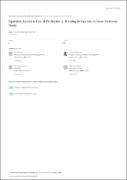| dc.contributor.author | Galukande, M. | |
| dc.contributor.author | Maling, S. | |
| dc.contributor.author | Kabakyenga, J. | |
| dc.contributor.author | Nshaho, J. | |
| dc.contributor.author | Oboke, Henry | |
| dc.contributor.author | Oonge, B. | |
| dc.contributor.author | Muyenje, H. | |
| dc.contributor.author | Katumba-Sentongo, G. | |
| dc.contributor.author | Mayanja-Kizza, H. | |
| dc.contributor.author | Sewankambo, N.K. | |
| dc.date.accessioned | 2019-09-12T10:54:57Z | |
| dc.date.available | 2019-09-12T10:54:57Z | |
| dc.date.issued | 2018 | |
| dc.identifier.citation | Galukande, M., Maling, S., Kabakyenga, J., Nshaho, J., Oboke, H., Oonge, B., ... & Sewankambo, N. K. (2018). Equitable Access to Health Professional Training in Uganda: A Cross Sectional Study. Annals of global health, 84(1). | en_US |
| dc.identifier.uri | https://hdl.handle.net/123456789/62 | |
| dc.description.abstract | Objective: We set out to assess inequalities to access health professional education, and the impact of an education improvement program supported by MEPI (Medical Education Partnership Initiative). Inequalities in the higher education system in sub-Saharan Africa remain despite some transformative policies and affirmative action.
Methods: We reviewed enrollment data from four universities for the period 2001–2014 for various health professional training programs, and conducted group discussions through an iterative process with selected stakeholders, and including a group of education experts. Two time periods, 2001–2010 and 2011–2014, were considered. In 2010–11, the MEPI education program began. Gender ratios, regional representation, secondary schools, and the number of admissions by university and year were analysed. We used SPSS version 17 software to analyse these data with level of significance p < 0.05. We collated qualitative data along predetermined and emerging themes.
Results: The overall male-to-female ratio among the student population was 2.3:1. In total, there were 7,023 admissions, 4,403 between 2001–2010 (440 per annum) and 2,620 between 2011–2014 (655 per annum) with p = 0.018. There were no significant increases in admissions in the central and western regions over the two time periods, 1,708 to 849 and 1,113 to 867 respectively, both p = 0.713 and p = 0.253. We propose improving the university admission criteria and increasing enrollment to health professions training schools.
Conclusion: There were significant inequalities for higher education training in Uganda by gender, regional representation and school attended. Modifying the admission criteria and increasing enrollment may reduce these inequalities. | en_US |
| dc.language.iso | en | en_US |
| dc.publisher | Annals of global health | en_US |
| dc.subject | Health Professional Training | en_US |
| dc.title | Equitable Access to Health Professional Training in Uganda: A Cross Sectional Study | en_US |
| dc.type | Article | en_US |

